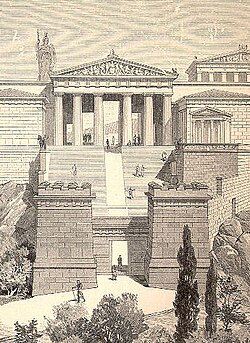Inancient Greek architecture,apropylaion,propylaeonor, in itsLatinizedform,propylaeum—often used in the plural formspropylaiaorpropylaea(/prɒpɪˈliːə/;Greek:προπύλαια)—is a monumentalgateway.It serves as a partition, separating the secular and religious parts of a city. The prototypical Greek example is the propylaea thatserved as the entranceto theAcropolis of Athens.TheGreek RevivalBrandenburg GateofBerlinand thePropylaeainMunichboth evoke the central portion of the Athens Propylaea.


Etymology
editThe Greek word προπύλαιον,propylaeon(propylaeumis theLatinversion), is the union of theprefixπρο-,pro-,"before, in front of", plus the plural of πύλη,pyle,"gate", meaning literally "that which is before the gates", but the word has come to mean simply "gate building".
Propylaea of the Athenian Acropolis
editThe propylaea were the monumental gates to the Acropolis, commissioned by the Athenian leaderPericlesin order to rebuild the Acropolis at the conclusion of theGreco-Persian Wars.These propylaea were built wide enough to allow chariots through. The construction was part of Pericles' great rebuilding program for Athens inc. 437BCE. The project of the Propylaea began once the Parthenon was almost done. It was overseen by the Athenian architect Mnesicles. Though the work was suspended due to the Peloponnesian War, the important pieces of Mnesicles' vision were able to come through. The architecture is unique in that the horizontal beams across the roof were supported by marble girders, which were supported by iron bars. The only other known use of metal in Greek architecture for structural purposes is theTemple of Zeus at Agrigento.
Propylaea outside the Greco-Roman world
editThe oldest known freestandingpropylaeumis the one located at the palace area inPasargadae,anAchaemenidcapital.[1]
A covered passage, called "the Propylaeum", used to face thePalace of Darius in Susa.[2]
In the 18th century, the Athenian Propylaea inspiredCarl Gotthard Langhansin construction of theBrandenburg GateinBerlin.
See also
editReferences
edit- ^electricpulp."PASARGADAE – Encyclopaedia Iranica".iranicaonline.org.Retrieved23 April2018.
- ^"SUSA iii. THE ACHAEMENID PERIOD – Encyclopaedia Iranica".iranicaonline.org.Retrieved2017-07-11.
Bibliography
edit- Berve, H.; Gruben, G.; and Hirmer, M.Greek Temples, Theaters, and Shrines(New York, 1963). A general look at selected Greek structures.
- Dinsmoor, William Bell (1922), "Structural Iron in Greek Architecture",American Journal of Archaeology,XXVI.
- Dinsmoor, W. B.,The Architecture of Ancient Greece(New York, 1975 – but actually a reprint of the 1950 publication). A general book on Greek architecture; dated in many areas but valuable for the Propylaea.
- Dinsmoor, W. B. Jr.,The Propylaia I: The Predecessors(Princeton, 1980). A careful study of the predecessors of the Propylaea.
- Eiteljorg, Harrison, II,The Entrance to the Acropolis Before Mnesicles(Dubuque, 1993). A careful study of the predecessors of the Propylaea, with very different conclusions from those of Dinsmoor above.
- Lawrence, A. W.,Greek Architecture(Baltimore, 1973). A general book on Greek architecture.
- Robertson, D.S.Greek and Roman Architecture'(Cambridge, 1969). A general book on Greek and Roman architecture. Available in paper, this may be the best place to begin for those with no knowledge of ancient architecture.
- Travlos, J.,Pictorial Dictionary of Ancient Athens(London, 1971). An encyclopedic approach to the monuments of Athens.
- The Perseus Project. An electronic resource that provides quick information, but some of the information about the Propylaea was incorrect when the site was last checked. Several good photographs of the Propylaea are available through the Perseus project.
- Cartwright, Mark. "Propylaea".World History Encyclopedia,Https://Www.worldhistory.org#Organization, 24 July 2022, https:// worldhistory.org/Propylaea/.
External links
edit- Propylaea.org– leads to a variety of material, some scholarly, but many photographs as well